Gear MITSUBISHI L200 2011 Owner's Manual (in English)
[x] Cancel search | Manufacturer: MITSUBISHI, Model Year: 2011, Model line: L200, Model: MITSUBISHI L200 2011Pages: 330, PDF Size: 22.34 MB
Page 6 of 330
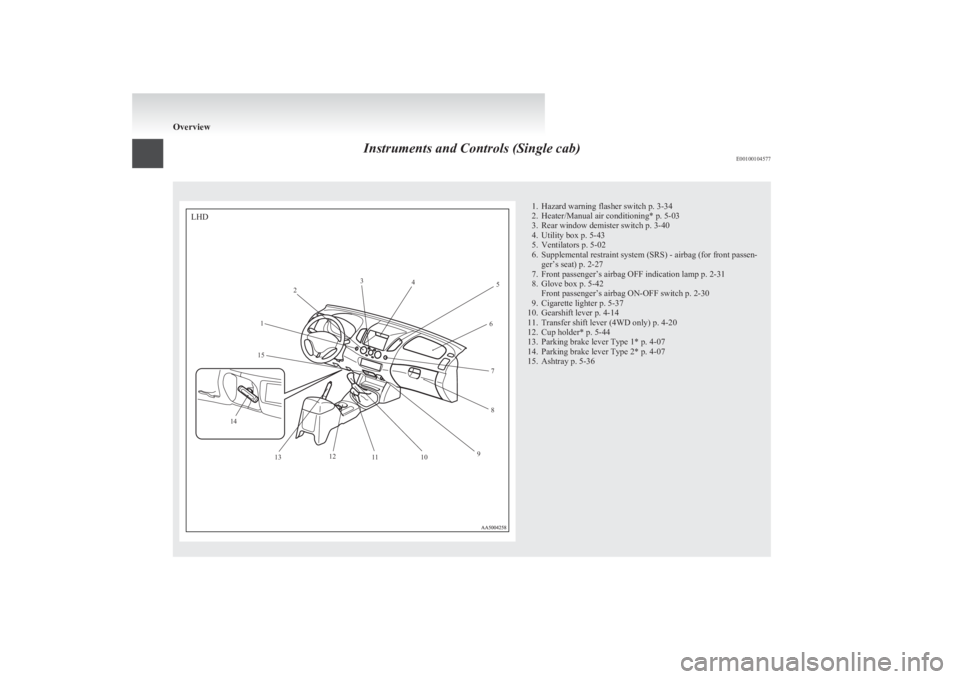
Instruments and Controls (Single cab)E001001045771. Hazard warning flasher switch p. 3-34
2. Heater/Manual air conditioning* p. 5-03
3. Rear window demister switch p. 3-40
4. Utility box p. 5-43
5. Ventilators p. 5-02
6. Supplemental restraint system (SRS) - airbag (for front passen- ger’s seat) p. 2-27
7. Front passenger’s airbag OFF indication lamp p. 2-31
8. Glove box p. 5-42 Front passenger’s airbag ON-OFF switch p. 2-30
9. Cigarette lighter p. 5-37
10. Gearshift lever p. 4-14
11. Transfer shift lever (4WD only) p. 4-20
12. Cup holder* p. 5-44
13. Parking brake lever Type 1* p. 4-07
14. Parking brake lever Type 2* p. 4-07
15. Ashtray p. 5-36
Overview12
3
4
5
6
78
9
10
11
12
13
14 15
LHD
Page 7 of 330
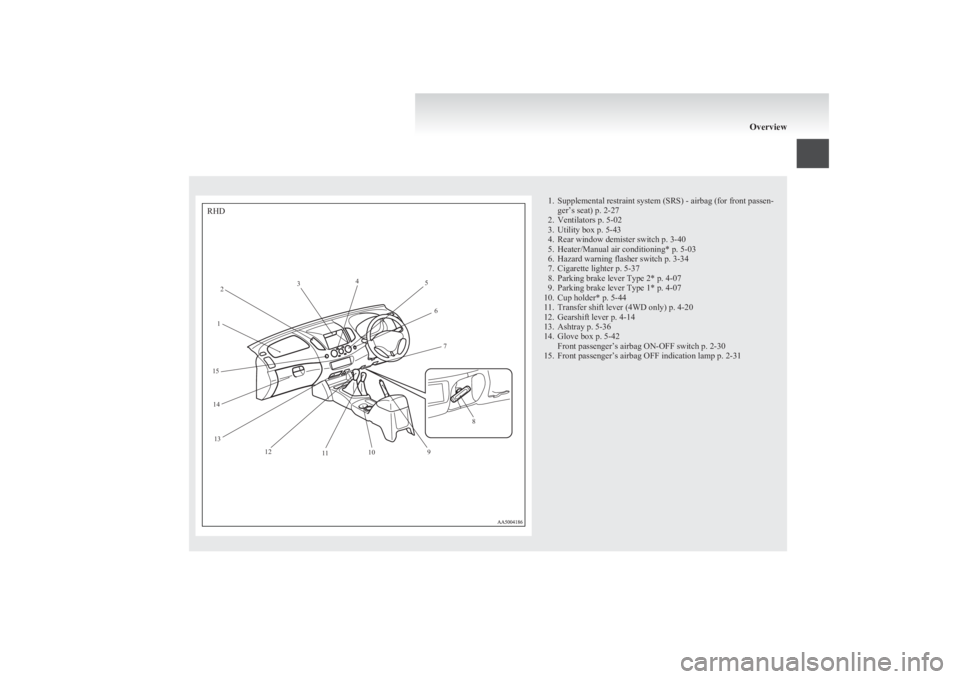
1. Supplemental restraint system (SRS) - airbag (for front passen-ger’s seat) p. 2-27
2. Ventilators p. 5-02
3. Utility box p. 5-43
4. Rear window demister switch p. 3-40
5. Heater/Manual air conditioning* p. 5-03
6. Hazard warning flasher switch p. 3-34
7. Cigarette lighter p. 5-37
8. Parking brake lever Type 2* p. 4-07
9. Parking brake lever Type 1* p. 4-07
10. Cup holder* p. 5-44
11. Transfer shift lever (4WD only) p. 4-20
12. Gearshift lever p. 4-14
13. Ashtray p. 5-36
14. Glove box p. 5-42 Front passenger’s airbag ON-OFF switch p. 2-30
15. Front passenger’s airbag OFF indication lamp p. 2-31
Overview12
3
4
5
6
7
8
9
10
11
12
13
14
15
RHD
Page 8 of 330
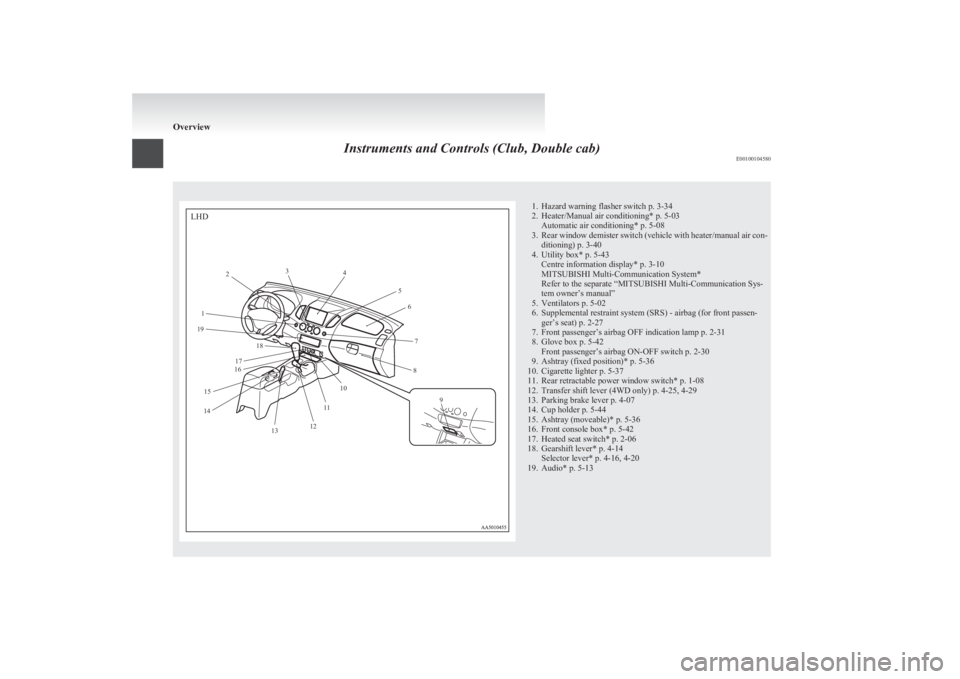
Instruments and Controls (Club, Double cab)E001001045801. Hazard warning flasher switch p. 3-34
2. Heater/Manual air conditioning* p. 5-03 Automatic air conditioning* p. 5-08
3. Rear window demister switch (vehicle with heater/manual air con-
ditioning) p. 3-40
4. Utility box* p. 5-43 Centre information display* p. 3-10
MITSUBISHI Multi-Communication System*
Refer to the separate “MITSUBISHI Multi-Communication Sys-
tem owner’s manual”
5. Ventilators p. 5-02
6. Supplemental restraint system (SRS) - airbag (for front passen- ger’s seat) p. 2-27
7. Front passenger’s airbag OFF indication lamp p. 2-31
8. Glove box p. 5-42 Front passenger’s airbag ON-OFF switch p. 2-30
9. Ashtray (fixed position)* p. 5-36
10. Cigarette lighter p. 5-37
11. Rear retractable power window switch* p. 1-08
12. Transfer shift lever (4WD only) p. 4-25, 4-29
13. Parking brake lever p. 4-07
14. Cup holder p. 5-44
15. Ashtray (moveable)* p. 5-36
16. Front console box* p. 5-42
17. Heated seat switch* p. 2-06
18. Gearshift lever* p. 4-14 Selector lever* p. 4-16, 4-20
19. Audio* p. 5-13
OverviewLHD1 2
3
4
56
7
8
9
10
11
12
13
14 15 16
17 18
19
Page 9 of 330
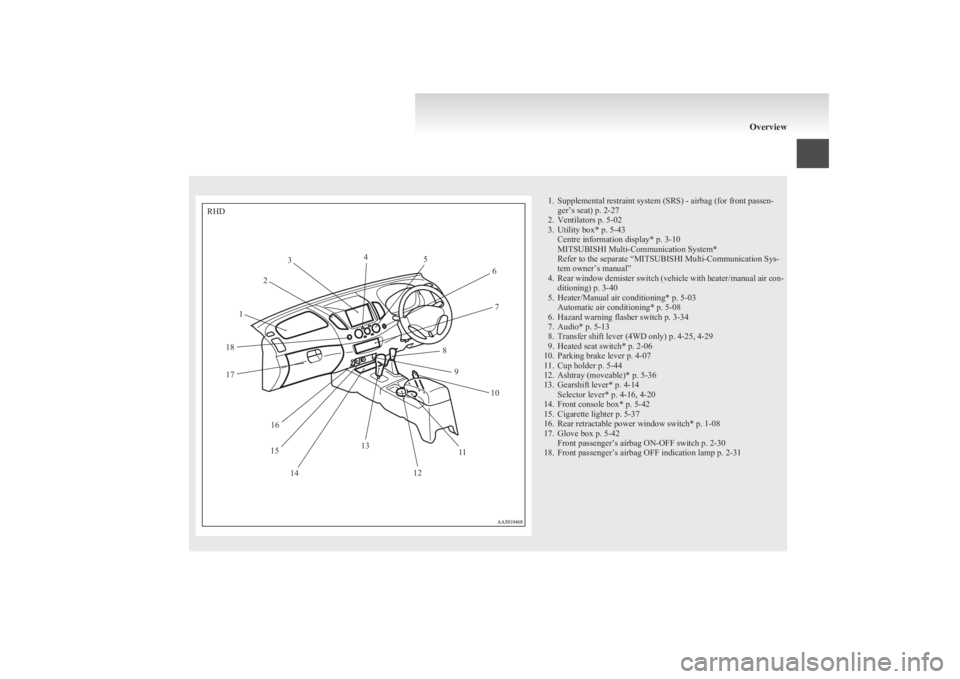
1. Supplemental restraint system (SRS) - airbag (for front passen-ger’s seat) p. 2-27
2. Ventilators p. 5-02
3. Utility box* p. 5-43 Centre information display* p. 3-10
MITSUBISHI Multi-Communication System*
Refer to the separate “MITSUBISHI Multi-Communication Sys-
tem owner’s manual”
4. Rear window demister switch (vehicle with heater/manual air con-
ditioning) p. 3-40
5. Heater/Manual air conditioning* p. 5-03 Automatic air conditioning* p. 5-08
6. Hazard warning flasher switch p. 3-34
7. Audio* p. 5-13
8. Transfer shift lever (4WD only) p. 4-25, 4-29
9. Heated seat switch* p. 2-06
10. Parking brake lever p. 4-07
11. Cup holder p. 5-44
12. Ashtray (moveable)* p. 5-36
13. Gearshift lever* p. 4-14 Selector lever* p. 4-16, 4-20
14. Front console box* p. 5-42
15. Cigarette lighter p. 5-37
16. Rear retractable power window switch* p. 1-08
17. Glove box p. 5-42 Front passenger’s airbag ON-OFF switch p. 2-30
18. Front passenger’s airbag OFF indication lamp p. 2-31
OverviewRHD12
3
4
5
6
7
8 9 10
11
12
13
14
15 16
17
18
Page 128 of 330

Economical drivingE00600100620
For economical driving, there are some technical re-
quirements that have to be met. The prerequisite
for low fuel consumption is a properly adjusted en-
gine. In order to achieve longer life of the vehicle
and the most economical operation, we recommend
you to have the vehicle checked at regular intervals
in accordance with the service standards.
Fuel economy and generation of exhaust gas and
noise are highly influenced by personal driving hab-
its as well as the particular operating conditions.
The following points should be observed in order
to minimize wear of brakes, tyres and engine as
well as to reduce environmental pollution.
Starting
Avoid rapid acceleration and sudden starts; such op-
eration will result in higher fuel consumption.
Shifting
Shift only at an appropriate speed and engine
speed. Always use the highest gear possible.
The transfer shift lever should be set to “2H” when
driving 4WD vehicles on normal roads and express
ways to obtain best possible fuel economy.
City traffic
Frequent starting and stopping increases the aver-
age fuel consumption. Use roads with smooth traf-
fic flow whenever possible. When driving on con-
gested roads, avoid use of a low gear at high en-
gine speeds.
Idling
The vehicle consumes fuel even during idling.
Avoid extended idling whenever possible.Speed
The higher the vehicle speed, the more fuel con-
sumed. Avoid driving at full speed. Even a slight re-
lease of the accelerator pedal will save a significant
amount of fuel.
Tyre inflation pressure
Check the tyre inflation pressures at regular inter-
vals. Low tyre inflation pressure increases road re-
sistance and fuel consumption. In addition, low
tyre pressures adversely affect tyre wear and driv-
ing stability.
Load
Do not drive with unnecessary articles in the cargo
area. Especially during city driving where frequent
starting and stopping is necessary, the increased
weight of the vehicle will greatly affect fuel con-
sumption.
Cold engine starting
Starting of a cold engine consumes more fuel.
Unnecessary fuel consumption is also caused by
keeping a hot engine running. After the engine is
started, commence driving as soon as possible.
Air conditioning*
The use of the air conditioning will increase the
fuel consumption.Driving, alcohol and drugs E00600200012
Driving after drinking alcohol is one of the most fre-
quent causes of accidents.
Your driving ability can be seriously impaired even
with blood alcohol levels far below the legal mini-
mum. If you have been drinking, don’t drive. Ride
with a designated non-drinking driver, call a cab or
a friend, or use public transportation.
Drinking coffee or taking a cold shower will not
make you sober.
Similarly, prescription and nonprescription drugs af-
fect your alertness, perception and reaction time.
Consult with your doctor or pharmacist before driv-
ing while under the influence of any of these medi-
cations.WARNINGl NEVER DRINK AND DRIVE.
Your perceptions are less accurate, your
reflexes are slower and your judgment is
impaired.
Starting and driving
4-02
4
Page 130 of 330

Running-in recommendationsE00600402135
During the running-in period for the first 1,000 km (620 miles), it is advisable to drive your new vehicle using the following precautions as a guideline to aid long
life as well as future economy and performance.
l Do not race the engine at high speeds.
l Avoid rapid starting, accelerating, braking and prolonged high-speed running.
l Keep to the running-in speed limit shown below.
Please note that the legal speed limits displayed must be adhered to.
l Do not exceed loading limits.
l Refrain from towing a trailer.Vehicles with manual transmission
Shift point
Speed limit2WDVehicles with easy select 4WDVehicles with super select 4WD2H, 4H4L2H, 4H, 4HLc4LLc1st
gear20 km/h (12 mph)20 km/h (12 mph)10 km/h (6 mph)20 km/h (12 mph)10 km/h (6 mph)2nd
gear40 km/h (25 mph)40 km/h (25 mph)20 km/h (12 mph)40 km/h (25 mph)20 km/h (12 mph)3rd
gear65 km/h (40 mph)70 km/h (43 mph)35 km/h (22 mph)70 km/h (43 mph)35 km/h (22 mph)4th
gear95 km/h (59 mph)100 km/h (62 mph)55 km/h (34 mph)100 km/h (62 mph)50 km/h (30 mph)5th
gear120 km/h (74 mph)130 km/h (81 mph)65 km/h (40 mph)130 km/h (81 mph)65 km/h (40 mph)
Starting and driving
4-04
4
Page 131 of 330
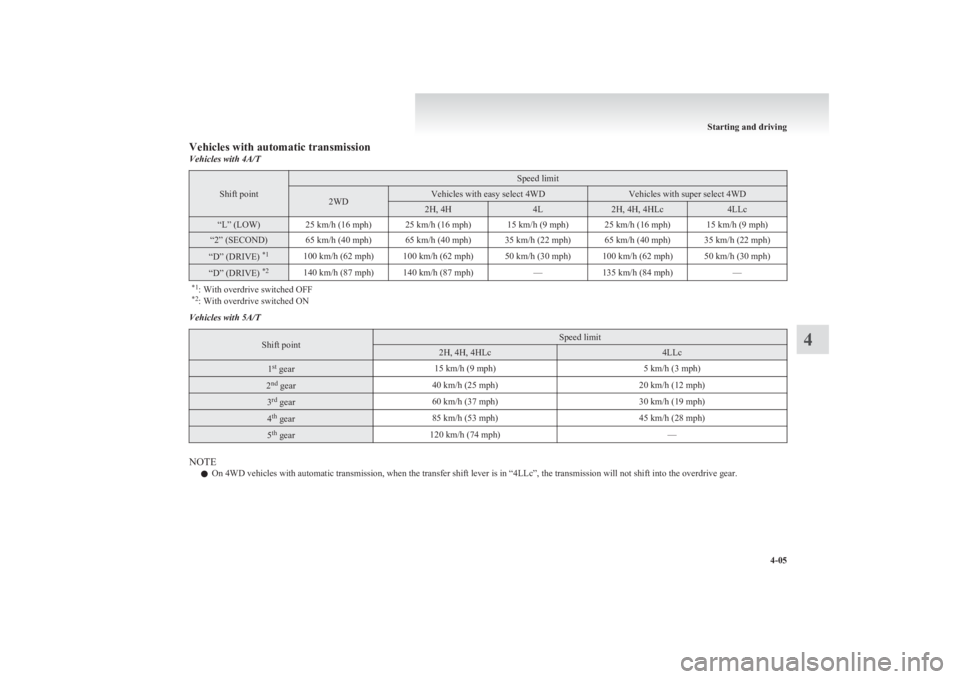
Vehicles with automatic transmissionVehicles with 4A/T
Shift point
Speed limit2WDVehicles with easy select 4WDVehicles with super select 4WD2H, 4H4L2H, 4H, 4HLc4LLc“L” (LOW)25 km/h (16 mph)25 km/h (16 mph)15 km/h (9 mph)25 km/h (16 mph)15 km/h (9 mph)“2” (SECOND)65 km/h (40 mph)65 km/h (40 mph)35 km/h (22 mph)65 km/h (40 mph)35 km/h (22 mph)“D” (DRIVE) *1100 km/h (62 mph)100 km/h (62 mph)50 km/h (30 mph)100 km/h (62 mph)50 km/h (30 mph)“D” (DRIVE) *2140 km/h (87 mph)140 km/h (87 mph)—135 km/h (84 mph)—*1
: With overdrive switched OFF
*2 : With overdrive switched ONVehicles with 5A/TShift pointSpeed limit2H, 4H, 4HLc4LLc1st
gear15 km/h (9 mph)5 km/h (3 mph)2nd
gear40 km/h (25 mph)20 km/h (12 mph)3rd
gear60 km/h (37 mph)30 km/h (19 mph)4th
gear85 km/h (53 mph)45 km/h (28 mph)5th
gear120 km/h (74 mph)—
NOTE
l On 4WD vehicles with automatic transmission, when the transfer shift lever is in “4LLc”, the transmission will not shift into the overdrive gear.
Starting and driving
4-05
4
Page 133 of 330
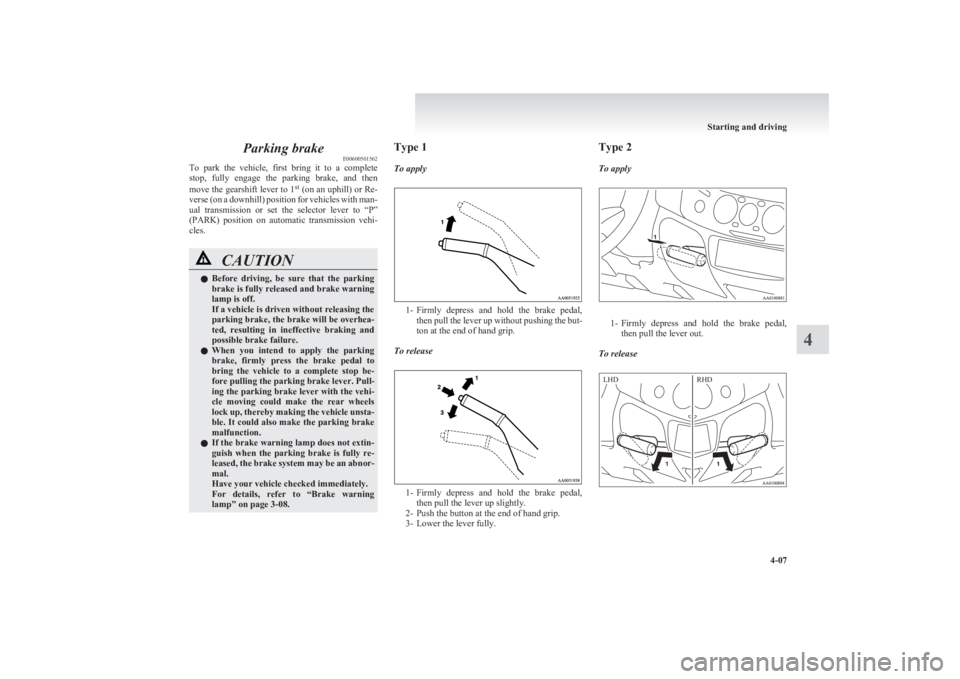
Parking brakeE00600501562
To park the vehicle, first bring it to a complete
stop, fully engage the parking brake, and then
move the gearshift lever to 1 st
(on an uphill) or Re-
verse (on a downhill) position for vehicles with man-
ual transmission or set the selector lever to “P”
(PARK) position on automatic transmission vehi-
cles.CAUTIONl Before driving, be sure that the parking
brake is fully released and brake warning
lamp is off.
If a vehicle is driven without releasing the
parking brake, the brake will be overhea-
ted, resulting in ineffective braking and
possible brake failure.
l When you intend to apply the parking
brake, firmly press the brake pedal to
bring the vehicle to a complete stop be-
fore pulling the parking brake lever. Pull-
ing the parking brake lever with the vehi-
cle moving could make the rear wheels
lock up, thereby making the vehicle unsta-
ble. It could also make the parking brake
malfunction.
l If the brake warning lamp does not extin-
guish when the parking brake is fully re-
leased, the brake system may be an abnor-
mal.
Have your vehicle checked immediately.
For details, refer to “Brake warning
lamp” on page 3-08.Type 1
To apply
1- Firmly depress and hold the brake pedal,
then pull the lever up without pushing the but-
ton at the end of hand grip.
To release
1- Firmly depress and hold the brake pedal,
then pull the lever up slightly.
2- Push the button at the end of hand grip.
3- Lower the lever fully.
Type 2
To apply
1- Firmly depress and hold the brake pedal,
then pull the lever out.
To release
Starting and driving
4-07
4 LHD RHD
Page 134 of 330

1-Firmly depress and hold the brake pedal,
then pull the lever out slightly and turn it
clockwise (LHD) or anticlockwise (RHD).
2- Push in the lever completely.
Parking E00600601202
Parking on a hill
To prevent the vehicle from rolling, follow these
procedures:
Parking on a downhill slope
Turn the front wheels towards the kerb and move
the vehicle forward until the kerb side wheel gently
touches the kerb.
Set the parking brake and place the gearshift lever
into the “R” (Reverse) position (with M/T) or the
selector lever into the “P” (PARK) position (with
A/T).
If necessary, apply chocks to wheels.
Parking on an uphill slope
Turn the front wheels away from the kerb and
move the vehicle back until the kerb side wheel gen-
tly touches the kerb.
Set the parking brake and place the gearshift lever
into the 1 st
position (with M/T) or the selector lever
into the “P” (PARK) position (with A/T).
If necessary, apply chocks to wheels.
NOTE l If your vehicle is equipped with
A/T, be sure
to apply the parking brake before moving the
selector lever to the “P” (PARK) position. If
you move the selector lever to the “P”
(PARK) position before applying the parking
brake, it may be difficult to disengage the se-
lector lever from the “P” (PARK) position
when next you drive the vehicle, requiring ap-
plication of a strong force to the selector lev-
er to move from the “P” (PARK) position.Parking with the engine running
Never leave the engine running while you take a
short sleep/rest. Also, never leave the engine run-
ning in a closed or poorly ventilated place.WARNINGl Leaving the engine running risks injury
or death from accidentally moving the
gearshift lever (on M/T vehicles) or the se-
lector lever (on A/T vehicles) or the accu-
mulation of toxic exhaust fumes in the pas-
senger compartment.
Where you park
Your front bumper can be damaged if you scrape it
over kerbs or parking stop blocks. Be careful when
travelling up or down steep slopes where your bump-
er can scrape the road.
WARNINGl Do not park your vehicle in areas where
combustible materials such as dry grass
or leaves can come in contact with a hot
exhaust, since a fire could occur.
When leaving the vehicle
Always remove the key from the ignition switch
and lock all doors when leaving the vehicle unatten-
ded.
Always try to park your vehicle in a well lit area.
Starting and driving
4-08
4LHD RHD
Page 139 of 330
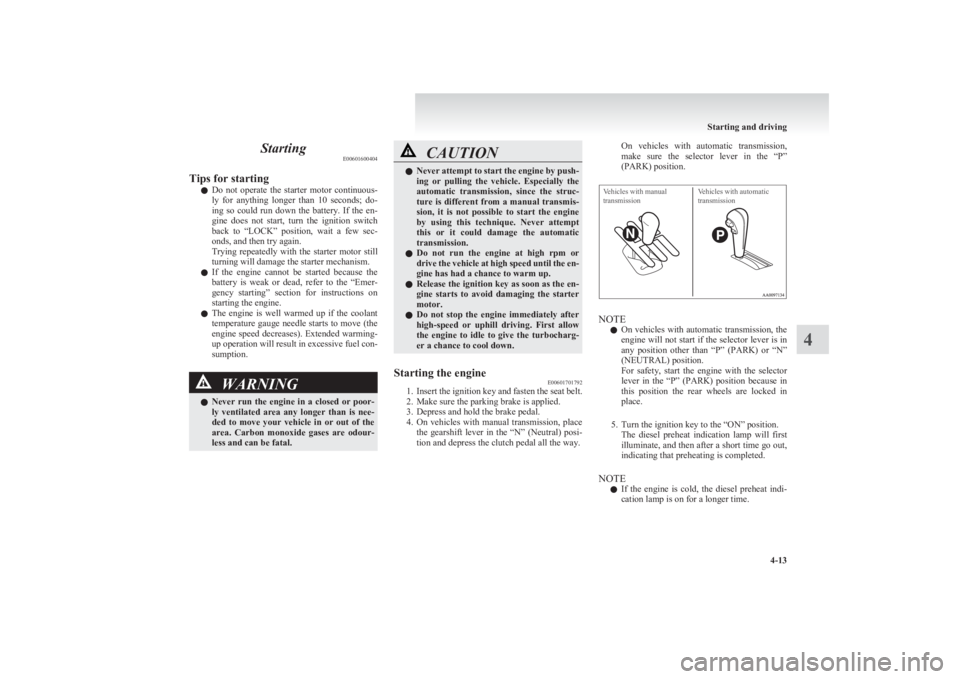
StartingE00601600404
Tips for starting l Do not operate the starter motor continuous-
ly for anything longer than 10 seconds; do-
ing so could run down the battery. If the en-
gine does not start, turn the ignition switch
back to “LOCK” position, wait a few sec-
onds, and then try again.
Trying repeatedly with the starter motor still
turning will damage the starter mechanism.
l If the engine cannot be started because the
battery is weak or dead, refer to the “Emer-
gency starting” section for instructions on
starting the engine.
l The engine is well warmed up if the coolant
temperature gauge needle starts to move (the
engine speed decreases). Extended warming-
up operation will result in excessive fuel con-
sumption.WARNINGl Never run the engine in a closed or poor-
ly ventilated area any longer than is nee-
ded to move your vehicle in or out of the
area. Carbon monoxide gases are odour-
less and can be fatal.CAUTIONl Never attempt to start the engine by push-
ing or pulling the vehicle. Especially the
automatic transmission, since the struc-
ture is different from a manual transmis-
sion, it is not possible to start the engine
by using this technique. Never attempt
this or it could damage the automatic
transmission.
l Do not run the engine at high rpm or
drive the vehicle at high speed until the en-
gine has had a chance to warm up.
l Release the ignition key as soon as the en-
gine starts to avoid damaging the starter
motor.
l Do not stop the engine immediately after
high-speed or uphill driving. First allow
the engine to idle to give the turbocharg-
er a chance to cool down.Starting the engine E00601701792
1.Insert the ignition key and fasten the seat belt.
2. Make sure the parking brake is applied.
3. Depress and hold the brake pedal.
4. On vehicles with manual transmission, place
the gearshift lever in the “N” (Neutral) posi-
tion and depress the clutch pedal all the way.
On vehicles with automatic transmission,
make sure the selector lever in the “P”
(PARK) position.Vehicles with manual
transmissionVehicles with automatic
transmission
NOTE
l On vehicles with automatic transmission, the
engine will not start if the selector lever is in
any position other than “P” (PARK) or “N”
(NEUTRAL) position.
For safety, start the engine with the selector
lever in the “P” (PARK) position because in
this position the rear wheels are locked in
place.
5. Turn the ignition key to the “ON” position. The diesel preheat indication lamp will first
illuminate, and then after a short time go out,
indicating that preheating is completed.
NOTE l If the engine is cold, the diesel preheat indi-
cation lamp is on for a longer time.
Starting and driving
4-13
4